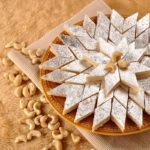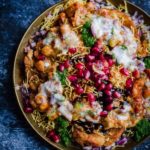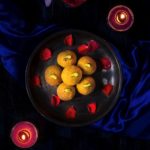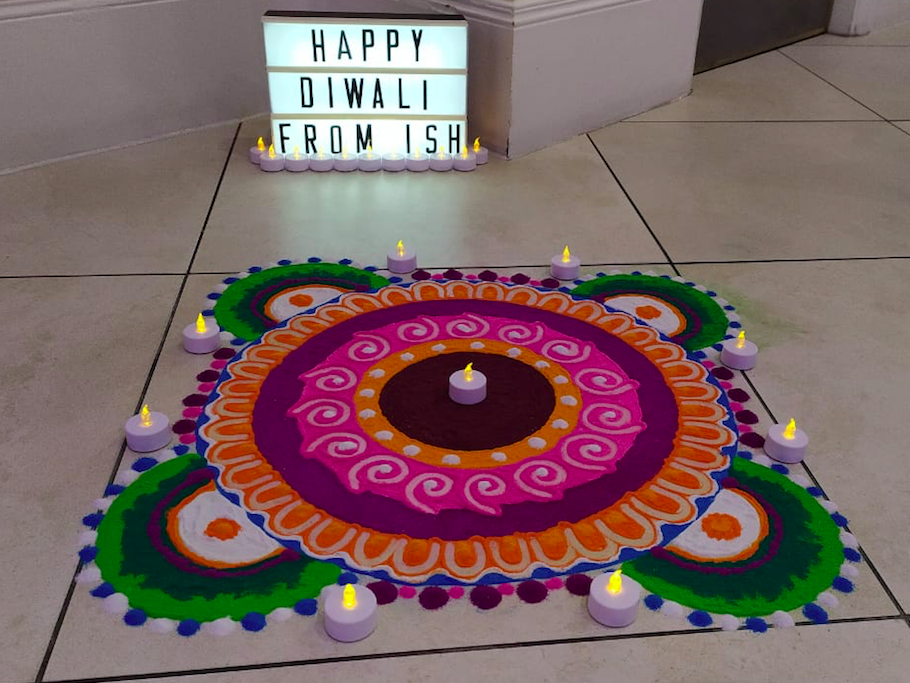Aditya Mukherjee, BA Global Politics and International Relations student, shares his recommendations for what to eat during the Diwali celebrations this week.
One of the most popular festivals in India, celebrated all over the world, Diwali, or Deepavali as it is known, is a festival of light that brings family and friends together. Taking place in November (based on the lunar calendar so dates change every year), it is the time of the year that many look forward to, as it brings families together. It is the time when households are lit with ‘diyas’ (traditional Indian lamps) in the evening to mark the victory of good over evil, and to welcome the Gods home.
In addition, it is also the time when people purchase new clothes, home items, electronics, and cars. More importantly, gifts are given to loved ones.
Food is an important aspect of the celebration, and many types of delicious dishes are made to celebrate every evening. Let’s discover some of the well-known foods that are almost always prepared during this festival (caution – most of them are desserts and deep fried, so if you have a sweet tooth, you are in for some cravings!)
1. Jalebi
“If you haven’t tried jalebi, you have not lived.” (Quote by an ancient Indian scholar) Deep fried spiral shaped batter covered in sugar syrup. This is not for the faint hearted.
2. Gagar-ka-Halwa (carrot halwa)
A delicious pudding made form slow cooked carrots simmered in milk along with a lot of jaggery (organic sweetener from sugarcane) and sugar. It usually has cardamom, cashews and raisins for aroma and flavour.
3. Gulab jamun (rose water berry)
Another sweet confectionary and a must have in any Indian celebration. Milk and cheese solids dough heated over a long time, later fried and soaked in sugar syrup.
4. Kheer (rice pudding)
Rice slowly cooked with milk, sugar, saffron and cardamom, creates the classic Indian pudding known as kheer. Cooked only on special occasions, it is a must have at a Diwali party. Nuts and dried fruit are also added for stimulating the palate.
5. Burfi (fudge)
Burfi’s are fudge, that can come in various textures and consistencies depending on the ingredients and spices used. Naturally, Indian burfis come in a pantheon of colors and flavors so there is always something for everyone when it comes to this desert. My all-time favourite is mango burfi and the regular or natural flavor (doodh) milk burfi.
Moving on to the savories, the contenders are: –
6. Samosas
A staple that is synonymous with Indian identity, samosas are triangular savoury pastries that are irresistible because they are crispy, yummy, spicy and, naturally a must have during celebratory events. Quite literally, a fried or baked pastry with a savoury filling such as a spiced potato mash with onions, lentils and peas. They are often eaten with condiments like mint and tamarind chutney (usually a choice of one sweet and once spicy chutney) for those who aspire to have the authentic experience.
7. Chakli (spirals)
A very popular Indian savory, these are made of rice and/or gram flower, that is of course deep fried along with spices and lentils, thus available in many different variations and flavours. Although commonly available and eaten, this is one of those snacks that is a favourite and finds its way onto menus for parties and celebrations very easily.
8. Pakora (spiced fritter)
Having several variations , pakoras are quintessential, easy to make and, have a lot of variety in flavours depending on the vegetables used that are coated in a gram flour batter, and totally deep-fried to the heart’s content. A mix of vegetables and spices may be added to diversify the palate but the most common are pieces of cauliflower, eggplant (aubergine), potatoes, and mixed vegetables. To enjoy, these are eaten with condiments, such as a mint or mango chutney on the side to fire up your taste buds.
9. Puri – bhaji
A traditional Indian dish, puri meaning deep fried rounds of flour, and bhaji meaning a potato vegetable, eaten together is an enjoyable and recognizable dish eaten during celebrations and auspicious occasions. Also known as a comfort food, the spices used in the bhaji vary from mustard seeds, onions, turmeric, coriander leaves, salt and pepper, which all blend to create the perfect mouthwatering vegetable dish.
10. Papdi chat
Papdi (deep fried dough) along with potato mash, chickpeas, onions, chutneys, tomatoes and spices, served with spices covered in yoghurt is known as papdi chat. As vibrant in its colour, as it is in its flavour, it is an enjoyable combination of sweet, savory, spices, crunchy and smooth textures to be enjoyed during the festive season.
Now don’t get me wrong, not everything is about eating!
Diwali is also an occasion where the art of ‘rangoli’ is made, usually in front of the main door of a house, or perhaps in a prominent place (can be indoors and outdoors as well) in order to welcome Lakshmi, Goddess of Wealth. ‘Rangoli’ are traditional Indian designs made by using coloured powders, that are attentively applied on the surface using all but 3 fingers to moderate the flow and fall of the colored powder to create exquisite designs, and are often accompanied with flowers and diyas. Some designs are passed down from generation to generation and it is definitely one of the most unique aspects of Diwali.
Evenings are marked with ‘pooja’ (prayers offered to the Gods), and thanks are given for all the good fortunes in the past and wishes made for the future. Later the night sky is lit up with firecrackers. So, out with the old and in with the new. This is a festival of lights, joy and togetherness. Wishing everyone a very Happy Diwali.




























